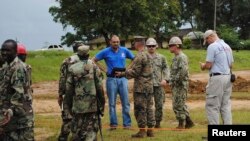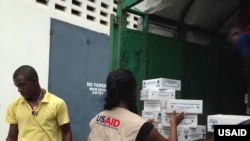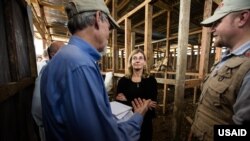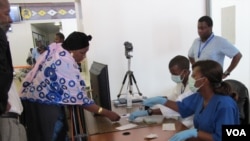As the Ebola crisis mushrooms in West Africa, the Obama administration is expanding its efforts to help defeat the deadly virus.
American military troops are deploying in Liberia, the country hardest hit by the outbreak. Their mission includes building at least 17 treatment centers with thousands more beds – aimed to provide hope, or at least comfort, for infected people sometimes left to die untended on the street.
Most U.S. activities in the region are less obvious, yet they're as vital and far-reaching as the emergency food and medical supplies delivered to treatment centers or the radio programing advising remote villagers how to guard against a stealthy killer.
The U.S. Agency for International Development, spending more than $20 million on Ebola relief since March, is funding a host of on-the-ground medical efforts. It has sent more than 500 tons of supplies and 130,000 sets of protective clothing to West Africa, with another 140,000 sets ready to ship.
The U.S. Centers for Disease Control and Prevention has sent teams of epidemiologists since the outbreak’s beginning to partner with local governments in tracking Ebola and raising public awareness. With analysts and support staff, it had nearly 140 employees in West Africa in early October.
"CDC is probably the best partner of WHO when it comes to infectious disease control," said Guenael Rodier, who’s coordinating the World Health Organization’s response in Guinea. "When it comes to science, CDC sets the standard."
In Guinea, periodic radio guest spots for Pierre Rollin, a French-speaking CDC epidemiologist, reportedly draw ratings surpassed only by Islamic evening prayers.
"He’s a rock star," said Alex Laskaris, U.S. ambassador to Guinea.
Other arms of the U.S. government, along with American NGOs, businesses, charities and individual donors, are pitching in to stop the terrifying virus that by early October killed at least 3,400 and infected twice as many.
Wide-ranging support
U.S. public and private contributions cover a broad range.
They include: supplying technical advice. Building treatment centers. Training locals to monitor people who’ve had direct contact with Ebola patients. Gathering data to help determine best treatment protocols or predict the next hot spots. Coordinating supply streams. Financing research on vaccines and therapies. Dispensing money and information to prevent or ease the massive suffering.
U.S. President Barack Obama announced beefed-up efforts in September to contain Ebola’s spread, mobilize more international support, and minimize economic and political fallout in the region.
The federal government set aside $1.3 billion to fight the outbreak in West Africa, including over $111 million in humanitarian aid and more than $1 billion for the Defense Department’s "whole-of-government" response.
By September's end, the U.S. agencies had spent or committed $208 million of the total.
US efforts criticized
But some critics see the U.S. efforts as being too little and too late.
The president’s move followed mounting criticism that the international community, including the U.S. government, was responding too slowly and inadequately to a crisis spiraling out of control.
"Six months into the worst Ebola epidemic in history, the world is losing the battle to contain it," Joanne Liu, head of the international aid group Doctors Without Borders, said at a special United Nations briefing in September. "Leaders are failing to come to grips with this transnational threat."
John Campbell, an expert on African affairs, called the newly broadened U.S. initiative "too late" and "too small given the magnitude of the crisis."
But Campbell – a former U.S. ambassador to Nigeria and now a senior fellow at the Council on Foreign Relations, a Washington think tank – said it exceeds what’s being done by most of America’s international partners.
"Chronic underfunding" of WHO, by the U.S. and other countries, slowed the health organization’s ability to assess the situation and muster more timely aid, he said.
"I see this as a failure on the part of the governments involved," Campbell said, "combined with very, very limited capacity [in the afflicted countries] and a failure on the part of international agencies to sound the alarm."
Personal US intervention
The current outbreak first was reported in March in Guinea’s southeast, near Sierra Leone and Liberia. This tri-border region "really is one in the sense of culture and language and kinship ties," said U.S. Ambassador Laskaris .
To discuss Ebola in countries with some of the world’s lowest literacy rates, officials relay health messages via pictograms – of figures vomiting, feverishly sweating and being directed to clinics. Those materials often show the CDC logo, alongside those of the respective country’s health ministry or international partners WHO and UNICEF.
To broaden Ebola awareness, the U.S. Embassy has provided $28,000 in equipment grants for radio stations in Gueckedou and Kissidougou, towns in Guinea’s beleaguered southeast region.
Local broadcasters translate the public-health messages into many of the country’s 25 languages.
But spotty electricity and high fuel costs for generators cut into communications. The United States, United Nations and other international partners are looking for ways to stabilize this.
A personal touch
Getting a grip on disease control requires loosening the physical bonds common in everyday West African life. Hugging and kissing has given way to elbow bumps or other hands-off gestures.
"No hug, no handshake, no nothing," said Aime Djong, a clerk at the upscale Palm Camayenne hotel in Conakry. She does embrace her father, she admitted, but "after that, you immediately wash your hands with alcohol."
Meredith Dixon, a pediatric specialist and CDC epidemiologist-in-training, greets people with a polite smile and head bob.
Modeling safe behavior comes with her job, she said, which is to collect and analyze data about Ebola. She recently arrived from Atlanta, Georgia, for her third tour in Guinea since April. This time, she plans to stay for three months to study Ebola and deepen the relationships important to her research.
Americans' cultural fight
Many Americans like Dixon find themselves battling cultural misunderstandings and false information.
News that the Pentagon committed 3,000 troops to the region – and possibility at least 1,000 more – has made many West Africans nervous of U.S. intentions.
Under U.S. Africa Command, the military has set up a regional staging base in Senegal, an "air bridge" through which it will deliver medical personnel and supplies.
Military personnel also are building the treatment centers and establishing a Liberian site for training an estimated 500 medical workers a week to provide hands-on care.
News of the military deployment fed a rumor that it masked plans for a U.S. takeover to replace the administration of Liberian President Ellen Johnson Sirleaf.
"There are always rumors," said Bill Berger, one of several U.S. representatives at a recent news conference organized to dispel that one.
Berger, based in Monrovia, leads a disaster assistance response team (DART) for USAID, coordinating the government’s response. Part of his job is to smooth conflicts while bolstering the infrastructure for civil society.
In Berger’s experience, skeptics eventually change their minds: "Frankly, once we’ve been here for a while, they see we’re here for humanitarian purposes."
His team’s 25 members – experts in health care, analytics, logistics and more, drawn from different parts of the government – primarily work in Liberia, with a few dispatched to Guinea and Sierra Leone.
A coordinations challenge
A main chore is linking key players and resources.
"Coordination is always a big challenge," Berger said. "… In Monrovia, one of the first things we did was help the government build a coordination center, so everybody who had a piece of this was in the same room."
The DART team directs U.S. funds to nongovernment groups, facilitates communication and orchestrates logistics.
"A lot of elements have to come together at the right time," Berger said, using the Ebola treatment centers as an example. "You have to staff them, you have to make sure the medical-supply pipeline is there."
USAID also is playing matchmaker, connecting nearly 2,200 prospective medical volunteers with the humanitarian groups that need them.
Some will get more U.S.-sponsored training and will wind up staffing those treatment centers. And that, Berger said, will mean a larger cadre of medically trained staff and heightened awareness of hygiene for the host country.
"There’s a goal that everything we do contributes to long-term development," he said, "so that we leave the country in a stronger position."
US border assistance
No one flies out of the three most-afflicted country’s international airports without encountering exit screening.
In theory, a short questionnaire, a quick interview and clearance by at least one by temperature-sensitive device will filter out potential disease carriers. In reality, a traveler’s informed, truthful accounting of possible exposure matters at least as much.
Guinea's health ministry began screening in April to contain the disease. The CDC helped it refine the process in July.
Travelers complete a short form – with help from an aide, if they can’t read.
Then, "we interrogate and take the temperature of each and every person before they get their boarding pass," said Daniel Frank, an epidemiologist with CDC’s Center for Global Health.
All airport and airline employees – from flight and cleaning crews to baggage handlers – get screened daily, too, he added.
Fourth-year medical students conduct the screening. An infrared camera trained near the airport entrance detects hot spots in the crowd. Each traveler’s temperature gets taken with a non-contact infrared thermometer aimed at the forehead.
Anyone with a fever or other indicator gets pulled aside for more testing, maybe even a trip to a nearby holding room and ambulance. Neither had been used as of late September.
The WHO also has recommended screenings at seaports and border crossings in the afflicted countries.
Frank recently visited one of Guinea’s 41 checkpoints, on the Sierra Leone border. In an email to VOA, he wrote that he was encouraged to find a hand-washing station plus five medical staffers “checking temps with thermo-flash devices and preventing folks with fever from passing.”
Increasing controls
With at least one confirmed case of Ebola in the United States and another in Spain, critics are agitating for tighter controls.
"We’re also going to be working on protocols to do additional passenger screening both at the source and here in the United States," Obama said recently.
Entry screening is beginning at the five U.S. airports that receive almost all travelers from West Africa. Travelers arriving from Guinea, Liberia and Sierra Leone will be diverted to a separate screening area to be assessed for signs of illness. Those with symptoms will be evaluated by a public health officer and possibly quarantined.
So far, federal officials have ruled out a travel ban, fearing it would prevent crucial people and supplies from reaching West Africa and would further destabilize the region’s economy.














